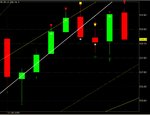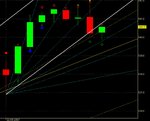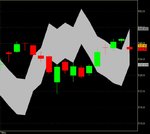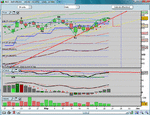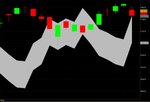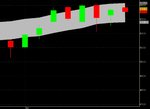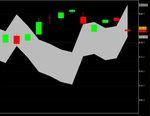The Dutch Clown
Established member
- Messages
- 592
- Likes
- 11
Week 21.
It has to be mentioned once again that not all the used techniques can be discussed each and every week in detail so you will have to combine the information from a number of different weeks. The backbone is the 2007 outlook so let’s look at the January 6 worksheet and put the year to date AEX into it (red line is AEX year to date, yellow is the 2007 projection worksheet). The origin of the worksheet data is in fact the DJIA so it’s not as much the exact price but more the rhythm that is of relevance. The rhythm of an index is not influenced by the content of the index itself only the price fluctuates within a tolerance level. Well it is in fact work in progress and I identified several area’s for improvement after all it’s not something which is immediately clear.
Rest assured I am not getting ahead of myself the cold hard indicator signaling remains the primary foundation for the trading decisions. The scenery in which those decisions will have to be made are interesting and help to improve for instance the Elliott Wave Analysis. If you recall the 409,56 fits best as fifth wave within the 217,80 pattern and I keep an alternative open that the high to come turns into the third wave. Similar thoughts will have to be made about the 409,56 sub-labeling which directly implicates the difference between the best scoring year to date pattern and the pattern that’s going to pop-up at the finish. Without getting into the merits of the many different patterns just look at your chart and consider 409,56 to 512,47 the first wave and 512,47 to 469,85 the second wave at least you notice the difference in elapsed time.
The 469,85 pattern best scoring scenario has a fifth wave up starting at 521,10. Within this wave the best scoring scenario is a WXYc pattern which has scored it’s first target at 535,30 and second at 538,38 almost (detail) when compared to the ideal pattern the third wave is running a bit too long. For next weeks trading roadmap we are going to start with the 525,65 pivot to keep all options open. Needless to add that there are a number of alternative wave counts left that might end up as a winner the best scoring scenario is static but can however be used for the outlines in the trading roadmap for this week. Depending on the actual price/time performance from 538,29 (probably Monday) one of the more complex corrective patterns that has five waves will come forward. The new school and additional indicators complete the picture for the P-trades.
It has been a while I have included the KVKD trending area systems so let’s look at two of them since they might help us this week. The 307,31 (!!!) weekly trending area indicated a relatively value which made me close my MLT positions some time ago, the value is still relatively high and indicates limited price rise with a Derivative Oscillator coming of it’s high value moving down. The 470,54 EOD trending area system is playing a role again with the threshold around 540 that kept back the AEX last week. If you consider the indicator remarks throughout the day it is best described like the price\time matrix needing to built up enough potential to knockdown the threshold, fair enough resistance. The 521,10 hourly trending area together with the Derivative Oscillator is going to help indicate if the price\time matrix charged adequately. To give you a rough idea, Monday morning the support area is around 535 and in that area the level of price correction should be made clear.
The main Astronomy for the stock-market objection has always been found in the Bradley indicator that never could tell the difference between a high and a low. The mentioned dates always included the plus and minus 1 to 3 day’s for something that might be a top or a bottom with a huge failure rate. The thought to be able to cover the factor time in a totally different way which is completely independent from the other variables (price and volume) is something so appealing that I continue the evolution tour. My first attempt, the Clowndicator, identifies timeslots using a layered structure generating harmonics where price tops might be expected and June has such a value although it must be mentioned that the major level is not included. So a June high does not relate to the longer timeframes like for instance the December2006\January 2007 value. The recent angle identifies both high and low also at different layers and the bear influence in May was spot on. Using this encouragement to do some further developing and testing in the analysis set-up into multiple layers linked to cycles or waves which are targeted to assists in trading for future time and direction.
Since volume popped up and Pacito mentioned it last week, I reviewed my own efforts and had to conclude I made just one serious volume effort and that is the MFI indicator. When I think about the Gann volume remarks I don’t come up with much more than that volume rises at relevant turning points. When volume represents the actual number of trades than what about the two involved parties, more specific their thoughts about the market direction. Even the question if the published volume does in fact represent the actual trading done is not as simple as it might seem. So basically I have not yet found the sound arguments to drop everything I am working on and start working full blown on volume.
From a trending point of view the weeks chart is positively trending between 527,70 and 541,11 in the projected trend chart. The daily version just entered the next slice between 529,30 and 542,72 last Friday. One of the other less known Wilder indicators the ADX is a reference for the strength of the trend. The daily chart shows a decline in the ADX whereas the AEX price rises and even though the DMI cross and valid buy signaling it has to be confirmed by a rising ADX soon.
Have fun trading to WIN.
It has to be mentioned once again that not all the used techniques can be discussed each and every week in detail so you will have to combine the information from a number of different weeks. The backbone is the 2007 outlook so let’s look at the January 6 worksheet and put the year to date AEX into it (red line is AEX year to date, yellow is the 2007 projection worksheet). The origin of the worksheet data is in fact the DJIA so it’s not as much the exact price but more the rhythm that is of relevance. The rhythm of an index is not influenced by the content of the index itself only the price fluctuates within a tolerance level. Well it is in fact work in progress and I identified several area’s for improvement after all it’s not something which is immediately clear.
Rest assured I am not getting ahead of myself the cold hard indicator signaling remains the primary foundation for the trading decisions. The scenery in which those decisions will have to be made are interesting and help to improve for instance the Elliott Wave Analysis. If you recall the 409,56 fits best as fifth wave within the 217,80 pattern and I keep an alternative open that the high to come turns into the third wave. Similar thoughts will have to be made about the 409,56 sub-labeling which directly implicates the difference between the best scoring year to date pattern and the pattern that’s going to pop-up at the finish. Without getting into the merits of the many different patterns just look at your chart and consider 409,56 to 512,47 the first wave and 512,47 to 469,85 the second wave at least you notice the difference in elapsed time.
The 469,85 pattern best scoring scenario has a fifth wave up starting at 521,10. Within this wave the best scoring scenario is a WXYc pattern which has scored it’s first target at 535,30 and second at 538,38 almost (detail) when compared to the ideal pattern the third wave is running a bit too long. For next weeks trading roadmap we are going to start with the 525,65 pivot to keep all options open. Needless to add that there are a number of alternative wave counts left that might end up as a winner the best scoring scenario is static but can however be used for the outlines in the trading roadmap for this week. Depending on the actual price/time performance from 538,29 (probably Monday) one of the more complex corrective patterns that has five waves will come forward. The new school and additional indicators complete the picture for the P-trades.
It has been a while I have included the KVKD trending area systems so let’s look at two of them since they might help us this week. The 307,31 (!!!) weekly trending area indicated a relatively value which made me close my MLT positions some time ago, the value is still relatively high and indicates limited price rise with a Derivative Oscillator coming of it’s high value moving down. The 470,54 EOD trending area system is playing a role again with the threshold around 540 that kept back the AEX last week. If you consider the indicator remarks throughout the day it is best described like the price\time matrix needing to built up enough potential to knockdown the threshold, fair enough resistance. The 521,10 hourly trending area together with the Derivative Oscillator is going to help indicate if the price\time matrix charged adequately. To give you a rough idea, Monday morning the support area is around 535 and in that area the level of price correction should be made clear.
The main Astronomy for the stock-market objection has always been found in the Bradley indicator that never could tell the difference between a high and a low. The mentioned dates always included the plus and minus 1 to 3 day’s for something that might be a top or a bottom with a huge failure rate. The thought to be able to cover the factor time in a totally different way which is completely independent from the other variables (price and volume) is something so appealing that I continue the evolution tour. My first attempt, the Clowndicator, identifies timeslots using a layered structure generating harmonics where price tops might be expected and June has such a value although it must be mentioned that the major level is not included. So a June high does not relate to the longer timeframes like for instance the December2006\January 2007 value. The recent angle identifies both high and low also at different layers and the bear influence in May was spot on. Using this encouragement to do some further developing and testing in the analysis set-up into multiple layers linked to cycles or waves which are targeted to assists in trading for future time and direction.
Since volume popped up and Pacito mentioned it last week, I reviewed my own efforts and had to conclude I made just one serious volume effort and that is the MFI indicator. When I think about the Gann volume remarks I don’t come up with much more than that volume rises at relevant turning points. When volume represents the actual number of trades than what about the two involved parties, more specific their thoughts about the market direction. Even the question if the published volume does in fact represent the actual trading done is not as simple as it might seem. So basically I have not yet found the sound arguments to drop everything I am working on and start working full blown on volume.
From a trending point of view the weeks chart is positively trending between 527,70 and 541,11 in the projected trend chart. The daily version just entered the next slice between 529,30 and 542,72 last Friday. One of the other less known Wilder indicators the ADX is a reference for the strength of the trend. The daily chart shows a decline in the ADX whereas the AEX price rises and even though the DMI cross and valid buy signaling it has to be confirmed by a rising ADX soon.
Have fun trading to WIN.



